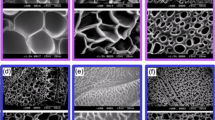Abstract
Purpose. The primary objective of this study is to perform detailed and extensive rheological characterization of rheology of carbomer (Carbopol) microgels formulated using a solvent system typically used in topical gel formulations. Solvents like glycerin and propylene glycol can alter rheology and drug delivery characteristics of topical gels owing to their different viscosities and due to the change in solvent-polymer and solvent-solvent interactions.
Methods. Aqueous gels with different pH were prepared by dissolving cross-linked Carbopol polymers in a co-solvent system comprising water, propylene glycol, and glycerol and subsequently neutralizing the carboxylic groups of the polymers with triethanolamine (TEA). Oscillatory, steady, and transient shear measurements were performed to measure viscoelastic properties, temperature dependency, yield strength, and thixotropy of carbomer pharmaceutical gels.
Results. The topical pharmaceutical gels exhibit remarkable temperature stability. Flow curves obtained at different temperatures indicate Carbopol microgels show much more pseudoplastic behavior (lower power law index) compared to Carbopol gels dissolved only in water. Substantial yield strength is required to break the microgel network of the topical gels. The gel samples exhibit modest thixotropy at higher deformation rates.
Conclusions. The rheological behavior of the Carbopol microgels do not change appreciably in the pH range 5.0-8.0, and the gels can be used as effective dermatological base for topical applications.
Similar content being viewed by others
References
M. Sjoberg, L. Bergstrom, A. Larsson, and E. Sjostrom. The effect of polymer and surfactant adsorption on the colloidal stability and rheology of kaolin dispersions. Colloids Surf. A, Physicochemical Eng. Asp. 159:197-208 (1999).
K. D. Bremecker, B. Koch, W. Krause, and L. Neuenroth. Application-triggered drug release from an O/W-emulsion. Pharm. Ind. 54:182-185 (1992).
J. Y. Kim, J. Y. Song, E. J. Lee, and S. K. Park. Rheological properties and microstructures of Carbopol gel network system. Colloid Polym. Sci. 281:614-623 (2003).
M. Yonese. Sustained drud delivery by gels. In Y. Osada and K. Kajiwara (eds.), Gels Handbook. Vol. 3, Academic Press, San Diego, CA, 2001, pp. 230-240.
S. Ding. Recent developments in ophthalmic drug delivery. Pharm. Sci. Tech. Today 1:328-335 (1998).
B. F. Goodrich. Polymers for pharmaceutical applications I. General overview, B. F. Goodrich, 1997.
S. Tamburic and D. Q. M. Craig. Rheological evaluation of polyacrylic acid hydrogels. Pharm. Sci. 1:107-109 (1995).
S. Tamburic and D. Q. M. Craig. An investigation into the rheological, dielectric and mucoadhesive properties of poly(acrylic acid) gel systems. J. Control. Rel. 32:59-68 (1995).
M. J. C. Fresno, A. D. Ramirez, and M. M. Jimenez. Systematic study of the flow behaviour and mechanical properties of Carbopol (R) Ultrez (TM) 10 hydroalcoholic gels. Europ. J. Pharm. Biopharm. 54:329-335 (2002).
M. J. F. Contreras, A. R. Dieguez, and M. M. J. Soriano. Rheological characterization of hydroalcoholic gels-15% ethanol-of Carbopol (R) Ultrez (TM) 10. Farmaco 56:437-441 (2001).
D. M. Plaiziervercammen. Rheological Properties of Carbopol-950 and Carbopol-954 neutralized with triethanolamine and Neutrol Te. Pharmazie 46:646-650 (1991).
J. S. Chu, D. M. Yu, G. L. Amidon, N. D. Weiner, and A. H. Goldber. Viscoelastic properties of polyacrylic acid gels in mixed solvents. Pharm. Res. 9:1659-1663 (1992).
H. O. Ho, F. C. Huang, T. D. Sokoloski, and M. T. Sheu. The influence of cosolvents on the in-vitro percutaneous penetration of diclofenac sodium from a gel system. J. Pharm. Pharmacol. 46:636-642 (1994).
A. Arellano, S. Santoyo, C. Martin, and P. Ygartua. Influence of propylene glycol and isopropyl myristate on the in vitro percutaneous penetration of diclofenac sodium from carbopol gels. Euro. J. Pharm. Sci. 7:129-135 (1999).
R. J. Ketz, R. K. Prud'homme, and W. W. Graessley. Rheology of concentrated microgel solutions. Rheol. Acta. 27:531-539 (1988).
H. N. Nae and W. W. Reichert. Rheological properties of lightly crosslinked carboxy copolymers in aqueous solutions. Rheol. Acta 31:351-360 (1992).
B. Testa and J. C. Etter. Report concerning rheology used to study interactions between carbopol macromolecules as well as semiquantitative determination of ionic force of their dispersions. Pharm. Acta Helv. 6:378-388 (1973).
J. D. Ferry. Viscoelastic Properties of Polymers, 3rd Ed., Wiley, New York, 1980.
R. Barreiro-Iglesias, C. Alvarez-Lorenzo, and A. Concheiro. Incorporation of small quantities of surfactants as a way to improve the rheological and diffusional behavior of carbopol gels. J. Control. Rel. 77:59-75 (2001).
W. P. Cox and E. H. Merz. Correlation of dynamic and steady flow viscosities. J. Polym. Sci. 28:619-622 (1958).
R. G. Larson. The Structure and Rheology of Complex Fluids, Oxford University Press, New York, 1999.
H. A. Barnes. A brief history of the yield stress. Appl. Rheol. 9:262-266 (1999).
D. D. Atapattu, R. P. Chhabra, and P. H. T. Uhlherr. Wall effect for spheres falling at small reynolds-number in a viscoplastic medium. J. Non-Newtonian Fluid. Mech. 38:31-42 (1990).
Q. D. Nguyen and D. V. Boger. Yield stress measurement for concentrated suspensions. J. Rheol. 27:321-349 (1983).
R. B. Bird, R. C. Armstrong, and O. Hassager. Dynamics of Polymer Liquids, 2nd Ed., Wiley, New York, 1987.
A. Ramirez, M. J. Fresno, M. M. Jimenez, and E. Selles. Rheological study of Carbopol (R) Ultrez (TM) 10 hydroalcoholic gels, I: Flow and thixotropic behavior as a function of pH and polymer concentration. Pharmazie 54:444-447 (1999).
J. Ferguson and Z. Kemblowski. Applied Fluid Rheology, Elsevier Applied Science, London and New York, 1992, Chap. 2 and 5.
M. J. F. Contreras, A. R. Dieguez, and M. M. J. Soriano. Viscosity and temperature relationship in ethanol/water mixtures gelified with Carbopol (R) Ultrez (TM) 10. Farmaco 56:443-445 (2001).
A. Ramirez, M. J. Fresno, M. M. Jimenez, and E. Selles. Rheological study of Carbopol (R) Ultrez (TM) 10 hydroalcoholic gels, II: Thermal and mechanical properties as a function of pH and polymer concentration. Pharmazie 54:531-534 (1999).
Author information
Authors and Affiliations
Corresponding author
Rights and permissions
About this article
Cite this article
Islam, M.T., Rodríguez-Hornedo, N., Ciotti, S. et al. Rheological Characterization of Topical Carbomer Gels Neutralized to Different pH. Pharm Res 21, 1192–1199 (2004). https://doi.org/10.1023/B:PHAM.0000033006.11619.07
Issue Date:
DOI: https://doi.org/10.1023/B:PHAM.0000033006.11619.07




